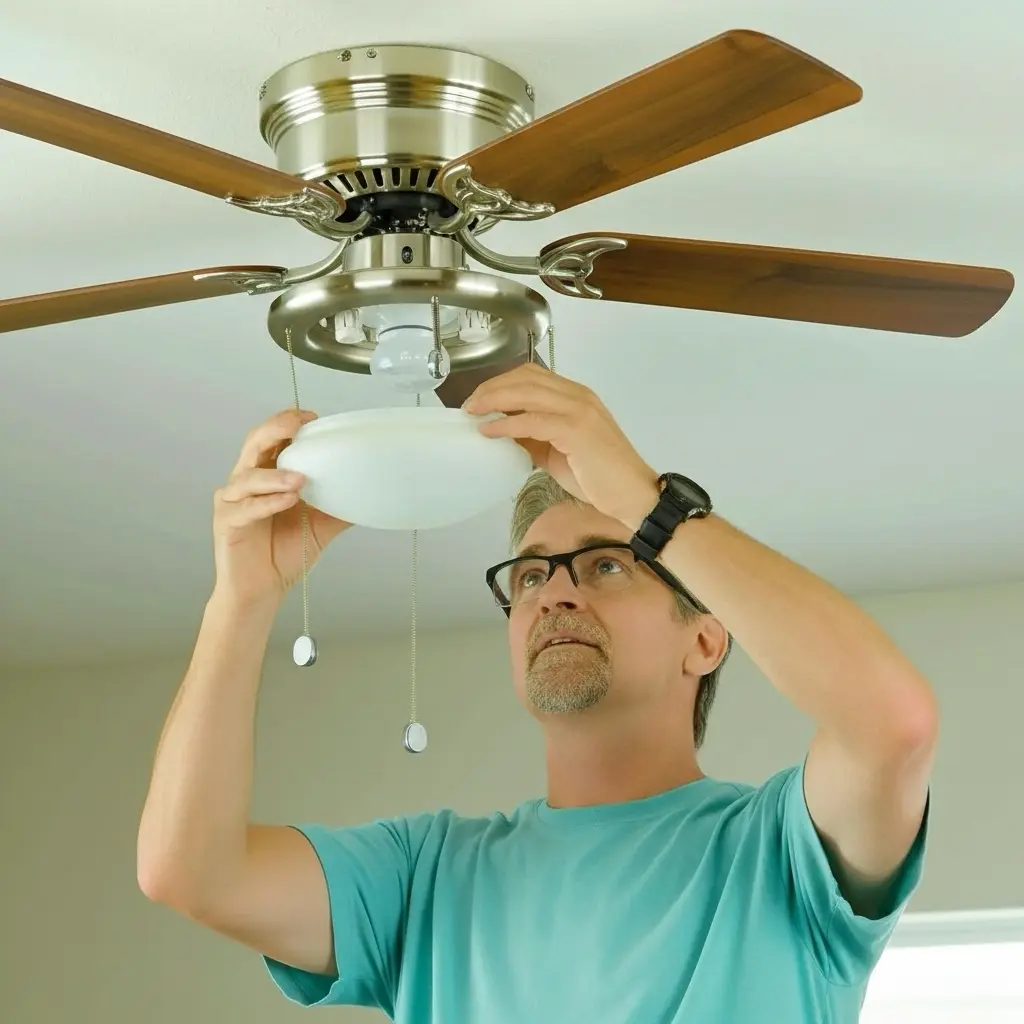Learn how to safely replace a ceiling fan tools, wiring, mounting, brand comparisons, costs, and U.S. code tips. Perfect for homeowners and electricians.
Replacing a ceiling fan is one of the simplest upgrades that can transform both comfort and efficiency in a U.S. home or commercial space. Whether you’re updating an aging motor, swapping styles, or installing an energy-saving smart model, understanding the right tools, wiring methods, and safety standards is crucial. This 2025 guide walks through every step from removal to testing plus brand comparisons, costs, and regional code notes to help you work confidently and safely.
Table of Contents
1) Why Replace a Ceiling Fan?
Over time, motors wear, blades lose balance, and newer Energy Star models can cut power use by 30–50 %. Upgrading also reduces noise, adds lighting options, and enables smart controls compatible with Alexa, Google Home, or HomeKit. Common reasons for replacement include:
- Persistent wobble or noise even after rebalancing.
- Outdated style or finish no longer matching décor.
- Faulty capacitor, remote, or light kit.
- Desire for integrated LED lighting and smart scheduling.
Figure 1 – Image Placeholder: “old-fan-vs-new-energy-star.jpg” side-by-side comparison of 1990s AC motor vs modern DC motor fan.

2) Tools and Materials Checklist
Before starting, gather all tools and verify circuit safety. You’ll need:
- Voltage tester or multimeter
- Phillips and flat screwdrivers
- Wire strippers and connectors (UL-listed)
- Adjustable wrench / pliers
- Step ladder rated ≥ 250 lb
- Fan-rated ceiling box (UL 507 / NEC 314.27 (D))
- Electrical tape, circuit labels, safety glasses
Always cut power at the breaker and confirm zero voltage before touching any wire.
3) Removing the Old Ceiling Fan
- Remove light bulbs and shades to lighten the fixture.
- Unscrew blade arms and label each if you plan to reuse them.
- Detach canopy cover to expose the mounting bracket and wiring.
- Test each conductor with a voltage tester; confirm power off.
- Disconnect wire nuts (typically black = hot, white = neutral, green = ground).
- Support the fan as you remove the mounting screws to avoid strain on wiring.
Figure 2 – Image Placeholder: “ceiling-fan-removal-diagram.png” — labeled diagram showing canopy, bracket, and wire disconnection.
4) Inspecting the Electrical Box & Support
The ceiling electrical box must be rated for fan support—standard light-fixture boxes aren’t strong enough. Check for:
- Stamped marking: “Suitable for Fan Support Up to 70 lb.”
- Secure attachment to joist or fan brace; no wobble.
- Grounding screw and intact insulation on wires.
If the box flexes, replace it with a metal fan-rated one using an adjustable bar brace (available at Home Depot or Lowe’s). Code reference: NEC 314.27 (C)(D).
5) Installing the New Fan
- Mounting Bracket & Downrod Prep : Secure the bracket to the fan-rated box. Assemble the downrod, ensuring the safety pin and cotter clip are in place.
- Wiring Connections :
- Black → hot (line in), White → neutral, Green / bare → ground.
- For two-switch systems: blue → light kit, black → fan motor.
- Tug each connection to confirm mechanical tightness.
- Canopy & Blade Installation : Secure canopy screws, attach blade arms using lock washers, and verify equal torque.
- Light Kit & Bulbs : Follow wattage limit printed on the housing (UL listing requirement).
- Balancing : Use the supplied clip/weight kit; run fan at low speed and adjust until wobble disappears.
Figure 3 – Chart Placeholder: “torque-vs-vibration-curve.png” — line chart showing reduced vibration after proper blade torqueing.
6) Wiring Diagram Reference (Single-Switch vs Dual-Switch)
Figure 4 – Image Placeholder: “single-dual-switch-wiring.png” — schematic comparing one-switch (combined fan/light) and two-switch circuits.
7) Brand Comparison (2025 U.S. Models)
| Brand / Series | Diameter (in) | Motor Type | CFM / W | Noise (dB) | Price Range (USD) |
|---|---|---|---|---|---|
| Hampton Bay – Mara Smart | 52 | DC | 85 | 48 | $160–$230 |
| Hunter – Builder Deluxe | 52 | AC | 67 | 51 | $120–$200 |
| Harbor Breeze – Armitage | 52 | AC | 64 | 53 | $90–$160 |
| Monte Carlo – Aviary | 56 | DC | 92 | 47 | $260–$400 |
8) Cost & Labor Comparison (DIY vs Professional)
| Method | Labor Time | Typical Cost (USD) | Code Compliance | Common Issues |
|---|---|---|---|---|
| DIY (Homeowner) | 1.5 – 2 hr | 0 – $50 (parts) | Depends on skill / inspection | Wiring errors, loose mounts |
| Licensed Electrician | 45 – 75 min | $125 – $200 | Guaranteed UL / NEC compliance | Minimal |
Figure 5 – Chart Placeholder: “cost-comparison-diy-vs-pro.png” — bar chart comparing total project cost and success rate.
9) Post-Installation Testing & Troubleshooting
- Turn breaker on → verify no sparks or odors.
- Cycle through speeds to check for hum or imbalance.
- If wobble > ⅛ inch, re-torque blades and use balancing clip.
- Test light kit separately (if dual circuit).
- Measure voltage (should be 110–120 V AC) at motor input if motor does not start.
Common Fixes
- No power: Check neutral continuity and wall switch output.
- Hum: Tighten mount screws and use rubber washers.
- Light flicker: Confirm bulb type (LED dimmable or non-dimmable).
10) Maintenance Tips for Long Life
- Dust blades monthly to maintain balance and airflow.
- Inspect screws and mounting hardware every 6 months.
- Lubrication not needed for sealed bearings (DC motors).
- Reverse direction each season (summer counter-clockwise / winter clockwise).
11) Safety & U.S. Code References
Compliance with national standards ensures both performance and insurance validity.
- UL 507 – Fan electrical safety listing.
- NEC 314.27 (D) – Ceiling boxes supporting fans.
- NEC 110.3(B) – Installation per listing and labeling.
- OSHA 29 CFR 1910 – Workplace electrical safety guidelines.
12) Energy Efficiency & ROI Benefits
Upgrading to a modern DC motor model reduces consumption from ≈ 70 W to ≈ 30 W on medium speed. At $0.14 /kWh and 8 hours/day usage, that’s ≈ $20 – $25 annual savings per fan plus cooling load reduction by raising the thermostat 2 °F.
Figure 6 – Chart Placeholder: “energy-consumption-before-after.png” — bar chart comparing old AC vs new DC motor energy use.
13) Conclusion
Replacing a ceiling fan is a straightforward project that offers immediate rewards—better comfort, lower bills, and updated style. By following UL and NEC guidelines, using a fan-rated box, and balancing properly, you’ll ensure quiet, efficient operation for years. Whether you’re a DIY homeowner in Texas or a licensed installer in Ohio, today’s DC smart fans make the upgrade worthwhile.
Need help? Find certified U.S. electricians or fan installers near you to ensure safe, code-compliant replacement and get a quote today.

